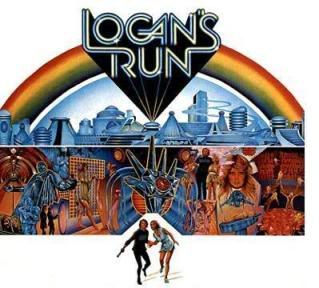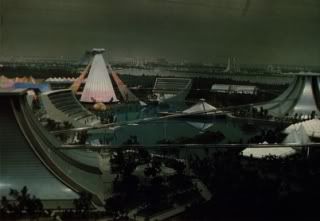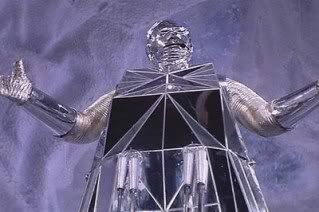
In 1967, William F Nolan and George Clayton Johnston penned a novel that had the potential to be one of the most scathing critiques of humanity ever written. Sadly, it was a work that didn't really aspire to lofty heights and settled for something slightly above mediocrity.
It portrayed a world where human self-indulgence had literally made the earth uninhabitable and it drew a picture where 60's Counterculture and the Sexual Revolution had gone into overdrive and suddenly became the thing they despised the most: the establishment.
The 60's hippie mantra of "don't trust anyone over 30" became a law enforced with an iron hand and unyielding lethality.
Welcome to the world of Logan's Run.

It portrayed a world where human self-indulgence had literally made the earth uninhabitable and it drew a picture where 60's Counterculture and the Sexual Revolution had gone into overdrive and suddenly became the thing they despised the most: the establishment.
The 60's hippie mantra of "don't trust anyone over 30" became a law enforced with an iron hand and unyielding lethality.
Welcome to the world of Logan's Run.

The late 1960's to mid 1970's saw yet another boom in the lucrative Sci-Fi film market. 20 Century Fox scored big in 1968 with Planet of the Apes and rumors were that they were working on yet another large sci-fi project (which turned out to be Star Wars).
MGM decided that they needed a franchise of their own to compete at the box office so they tapped Michael Anderson to direct an abridged version of Logan's Run. The pressure was on since the summer of the previous year saw the box office titan, JAWS, hit the big screens and all of a sudden, the timeframe between the middle of May and the end of August became the focal point of a movie studio's major releases.
The Summer Blockbuster was born.
While very successful (earning an Oscar for visual effects, a Saturn for Best Film, and earned $50 million on a $9 million budget), Logan's Run was doomed to be eclipsed by the sci-fi films that followed, primarily Star Wars (1977), Close Encounters of the Third Kind (1977), and Alien (1979).
MGM decided that they needed a franchise of their own to compete at the box office so they tapped Michael Anderson to direct an abridged version of Logan's Run. The pressure was on since the summer of the previous year saw the box office titan, JAWS, hit the big screens and all of a sudden, the timeframe between the middle of May and the end of August became the focal point of a movie studio's major releases.
The Summer Blockbuster was born.
While very successful (earning an Oscar for visual effects, a Saturn for Best Film, and earned $50 million on a $9 million budget), Logan's Run was doomed to be eclipsed by the sci-fi films that followed, primarily Star Wars (1977), Close Encounters of the Third Kind (1977), and Alien (1979).
As far as the plot goes, the film never really delves all that deeply into the more satirical parts of the Logan novels and wisely sticks to telling the basic story within a fairly resonable runtime.
In this dystopia, overpopulation and war have all but destroyed the human race. Mankind now lives in domed cities where their every need (from food to plastic surgery to human companionship via "The Circuit") is provided for by the computer that runs all housekeeping and life-support functions.
Population control is given a rather ritualistic twist. In the future all births are achieved through cloning. Sexual contact is purely recreational (and encouraged) but pregnancy is outlawed.
Each clone is fitted with a gem embedded in the palm of their left hand known as a lifeclock. At the age of 30, the lifeclock turns black and the citizen must go to Carousel where they are subsequently put to death.
There is a strong belief in this new society that despite the obvious genocide taking place, some souls will actually be reused for future clones and thus everyone has a shot at immortality.
Dystopia being what it is, we outside observers know that the promise of renewal is pure bunk and so does the computer that runs everything. Therefore, the computer correctly hypothesizes that it will require some sort of security detachment to help enforce its will. That's where the Sandmen come in, and where Logan 5 (Michael York) enters the picture.
Those who try to escape their fate on Carousel are dubbed "runners," and it is a Sandman's job to terminate all runners.

In this dystopia, overpopulation and war have all but destroyed the human race. Mankind now lives in domed cities where their every need (from food to plastic surgery to human companionship via "The Circuit") is provided for by the computer that runs all housekeeping and life-support functions.
Population control is given a rather ritualistic twist. In the future all births are achieved through cloning. Sexual contact is purely recreational (and encouraged) but pregnancy is outlawed.
Each clone is fitted with a gem embedded in the palm of their left hand known as a lifeclock. At the age of 30, the lifeclock turns black and the citizen must go to Carousel where they are subsequently put to death.
There is a strong belief in this new society that despite the obvious genocide taking place, some souls will actually be reused for future clones and thus everyone has a shot at immortality.
Dystopia being what it is, we outside observers know that the promise of renewal is pure bunk and so does the computer that runs everything. Therefore, the computer correctly hypothesizes that it will require some sort of security detachment to help enforce its will. That's where the Sandmen come in, and where Logan 5 (Michael York) enters the picture.
Those who try to escape their fate on Carousel are dubbed "runners," and it is a Sandman's job to terminate all runners.

Through the course of events of the film, the computer realizes that there is a small percentage of the population that remains unaccoutned for and assumes that despite its best efforts, citizens who decide to run are somehow managing to escape the confines of the domed city.
In a ruthlessly efficient response, the computer tasks Logan 5 with a secret mission. It alters Logan 5's lifeclock to make it appear as if Logan 5 is approaching his 30th birthday and then sends him out to make contact with any runner he can, so that he may follow the runner to Sanctuary (the mythical place where escaped runners have formed their own society) and destroy it.

In a ruthlessly efficient response, the computer tasks Logan 5 with a secret mission. It alters Logan 5's lifeclock to make it appear as if Logan 5 is approaching his 30th birthday and then sends him out to make contact with any runner he can, so that he may follow the runner to Sanctuary (the mythical place where escaped runners have formed their own society) and destroy it.

To this end, Logan 5 enlists the aid of Jessica (Jenny Agutter), a girl that Logan 5 meets through "The Circuit" and correctly suspects has some intention to "run."
To this day, I always include the wonderful folks at the MGM wardrobe department in my bedtime prayers for putting the stunning Miss Agutter in the killer, green piece of nothing you see her draped in below.

To this day, I always include the wonderful folks at the MGM wardrobe department in my bedtime prayers for putting the stunning Miss Agutter in the killer, green piece of nothing you see her draped in below.

Ahem... Anyway...
The following events see Logan and Jessica come to grips with startling realizations (primarily in the terrifying form of the insane robot, Box (Roscoe Lee Brown), and an amusing cameo from Peter Ustinov), catharsis, love, and finally in Logan's case, redemption.
You'll note that no one refers to the termination of runners or the renewal of those on Carousel as "death," and it is this philosophy along with the disturbingly utopian City of Domes that adds to the neo Genesis feel of the film with Logan and Jessica serving as our sci-fi version of Adam and Eve.
When the cost of paradise is paid with lives and individuality, then the only logical conclusion is to flee. Escaping from an Eden where nothing is as it appears to be is a very common theme in sci-fi and Logan's Run manages to put everything in a fairly entertaining package.

The following events see Logan and Jessica come to grips with startling realizations (primarily in the terrifying form of the insane robot, Box (Roscoe Lee Brown), and an amusing cameo from Peter Ustinov), catharsis, love, and finally in Logan's case, redemption.
You'll note that no one refers to the termination of runners or the renewal of those on Carousel as "death," and it is this philosophy along with the disturbingly utopian City of Domes that adds to the neo Genesis feel of the film with Logan and Jessica serving as our sci-fi version of Adam and Eve.
When the cost of paradise is paid with lives and individuality, then the only logical conclusion is to flee. Escaping from an Eden where nothing is as it appears to be is a very common theme in sci-fi and Logan's Run manages to put everything in a fairly entertaining package.

Watching Logan's Run in the present day has been bittersweet. The performances from the cast are acceptable enough to push the story along, but it really is a film that prefers style over substance. The story tends to drag during the parts where sleepguns aren't flashing or when Jenny Agutter isn't naked and the plot has holes large enough to drive a truck through.
I honestly think that this could've been one of those movies that might've been better than the book if it it had tried to more clearly address the society issues that the novel (and the novels that followed) only paid lip service to.
The caveat being that despite the rather average storytelling heights the novels aspired to, the basic concepts contributing to the premise were rather brave. The death age in the novels is 21, not 30, and I think that a project featuring young people (even minors) doing the same things that York and company did in this film would've never seen the light of day.
I still don't think society is ready for that sort of film, which probably explains why the oft-promised remake of Logan's Run still languishes in developmental hell. It's sort of tragic really.
In the 60's and early 70's, special effects really weren't at the stage where you could depict the changes in scenery or scope of concept in the Logan novels without spending tens of millions of dollars. The technology just wasn't there at the time.
Nowadays, the easiest thing to handle would be the special effects and it is the details of the story itself (especially in Logan's Run, where society is composed nearly entirely by teens and twenty-somethings) that would generate the most brow creasing and angst from film execs and audiences.
To this day, Logan's Run remains the semi-forgotten stepchild of the afterbirth of the Golden Age of Sci-Fi. An envelope pushing film rather than a groundbreaking one and certainly worth watching, however it certainly pales when compared to the true heavyweights of the genre that showed up when ILM changed all of the rules and Special FX became king.
I honestly think that this could've been one of those movies that might've been better than the book if it it had tried to more clearly address the society issues that the novel (and the novels that followed) only paid lip service to.
The caveat being that despite the rather average storytelling heights the novels aspired to, the basic concepts contributing to the premise were rather brave. The death age in the novels is 21, not 30, and I think that a project featuring young people (even minors) doing the same things that York and company did in this film would've never seen the light of day.
I still don't think society is ready for that sort of film, which probably explains why the oft-promised remake of Logan's Run still languishes in developmental hell. It's sort of tragic really.
In the 60's and early 70's, special effects really weren't at the stage where you could depict the changes in scenery or scope of concept in the Logan novels without spending tens of millions of dollars. The technology just wasn't there at the time.
Nowadays, the easiest thing to handle would be the special effects and it is the details of the story itself (especially in Logan's Run, where society is composed nearly entirely by teens and twenty-somethings) that would generate the most brow creasing and angst from film execs and audiences.
To this day, Logan's Run remains the semi-forgotten stepchild of the afterbirth of the Golden Age of Sci-Fi. An envelope pushing film rather than a groundbreaking one and certainly worth watching, however it certainly pales when compared to the true heavyweights of the genre that showed up when ILM changed all of the rules and Special FX became king.










7 comments:
Between this and American Werewolf In London, Jenny Agutter successfully pushed me headlong into puberty. :)
I like Logan's Run for what it is, but you're absolutely correct that it came at an unfortunate time. It's obviously a relic of the Omega Man/Soylent Green/THX-1138 era of Science Fiction, and looks particularly dated when thinking that Star Wars was only a year away and would re-write the rules.
I still think there's a lot to enjoy in it, though. Even if it really falls apart ridiculously in the final twenty minutes. I'll admit that the last time I watched it, the most amusing part was trying to see if a cat gets SQUASHED accidentally by Peter Ustinov. I remember some frame-by-frame analysis.
LOGAN'S RUN is another one of those movies that I've picked up and contemplated renting numerous times, but I've never gone through with it. Something about it seems slightly off-putting, but I can't tell you what it is.
I think the offputting quality of Logan's Run you might be experiencing could be attributed to the datedness that Doug described.
It really is hard to believe that films like Star Wars and Logan's Run are only a year apart, but that is probably credit due to the creation of ILM.
I don't think anyone realizes just how much ILM revolutionized the film industry.
I think that ILM, Disney's animation studios, and PIXAR are the three Hollywood institutions I admire most.
I think it's because it looks like Barbarella without the T&A.
Well, Jenny Aguter is indeed all kinds of nude in this movie and I think that Farrah Fawcett was as well but her scene ended up on the editing room floor in order to secure the PG rating.
There is one chase scene in the movie where Logan and Jessica stumble into what appears to be an orgy, but the scene is heavily edited.
Well, I'm sold.
I still think that there needs to be an unedited release of the orginal film.
It probably wouldn't have done well at the box office as an R rated movie back in the day, but I think it would've been closer to the spirit of the novels and told a more complete story.
You can't really tell a story about debauchery without showing some naughty bits, and I think there definitely needed to be a more complete picture as far as life in the City of Domes went.
If there is ever a remake, it needs to either be Rated R, or it needs to push the PG-13 envelope as far as it can.
Post a Comment